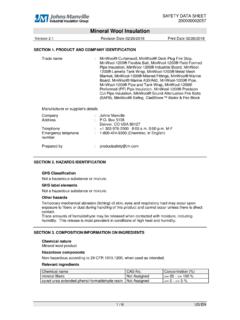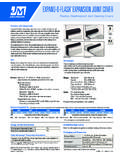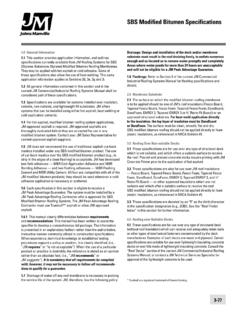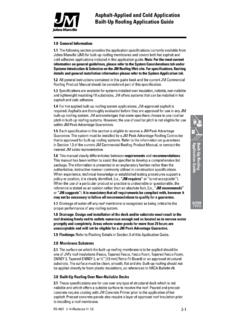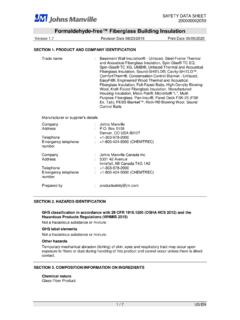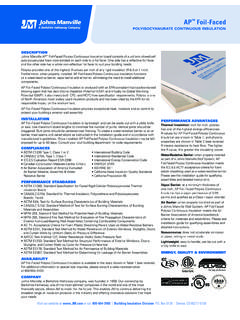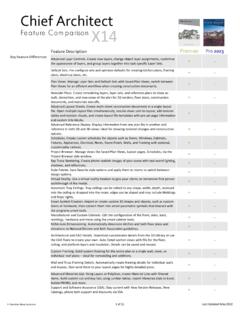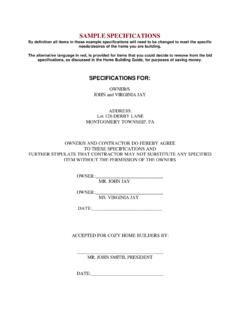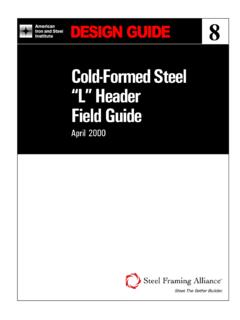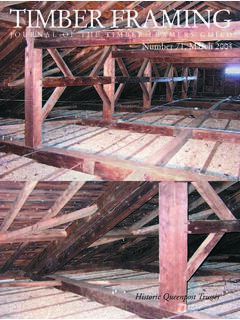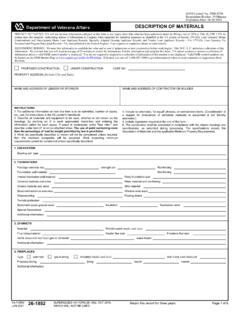Transcription of INSTALLATION INSTRUCTIONS FOR FIBER GLASS BATTS AND …
1 Personal Protective Equipment: INSTALLATION INSTRUCTIONS FOR FIBER GLASS BATTS AND ROLLSA Berkshire Hathaway CompanySite Preparation:Safety glasses with side shields are recommended to keep dust out of the eyes. Use ear protection (earplugs, hood, or earmuffs) to prevent airborne dust or fibers from entering the ear, if necessary. Leather or cotton gloves should be worn to protect against mechanical abrasion. Optional: wear a NIOSH-certified disposable or reusable particulate respirator with efficiency rating of N95 or higher (per 42 CFR 84) except required when dust or FIBER concentrations exceed the applicable exposure limits of dust 15 mg/m3. Wear a cap, a loose-fitting, long-sleeved shirt and long pants to protect skin from irritation.
2 Exposed skin areas should be washed with soap and water after handling or working with FIBER trades, including but not limited to, electrical, plumbing, and mechanical should have already installed their required materials prior to the FIBER GLASS being installed. Proper air sealing should be complete prior to FIBER GLASS batt INSTALLATION to insure full performance of the FIBER GLASS BATTS . Verify all holes and seams between sheet goods such as drywall, sheathing, and subflooring at the building envelope are sealed with durable caulk, tape, and/or foam sealants. 10100 W. Ute Avenue (80127) | Box 625005 | Littleton, CO 80162-5005303 978 2000 | Star Certification for ProductsOrder #6881100 Project #12CA35908 Johns Manville FIBER GLASS batt and roll insulation is easy to install and does not require a certified installer.
3 Wherever insulation is installed in a building, it is very important that it fits snugly on all sides. If the insulation is too long for a space, cut it to the correct size. If it is too short, cut a piece to fill the void. For unfaced BATTS , friction fit it into the cavities. If using faced BATTS , they may in friction fit or the flanges may be stapled to the wood studs. Use a Bostitch, Arrow or similar manual staple gun and 1/4", 5/16" or 3/8" staples, using enough staples to hold the insulation firmly in place and avoid gaps and fishmouths. 2014 Johns Manville Inc. All Rights Reserved | 2 Insulating Ceilings: How to Install Insulation In CeilingsHow to Insulate Your Cathedral CeilingInsulating Cathedral Ceilings: Ceiling insulation provides essential sound control between floors in your home.
4 Properly insulating the ceilings will make your home a more peaceful and quiet place because it will ensure that footsteps and other sounds do not migrate to other Seal around all penetrations in band joists. Any walls that leak water must be repaired before insulating. 2. Caulk where wiring runs through the ceiling joists and around the top of the wall. 3. Gently press the insulation between the joists. If you re using unfaced BATTS or rolls, allow friction to hold the insulation in place (called friction fit method ). If a polyethylene vapor retarder is used, staple it across the unfaced BATTS . Check to make sure there are no openings where moisture can escape. If you re using faced insulation, install it with the vapor retarder positioned down toward the room.
5 Hold the insulation up with one hand, while stapling the flange on both sides every 6" - 8" with the other hand. Leave a little extra on each end to cover the top plate of the outside wall. In attic installations, make sure the insulation completely covers the top plate of the outside wall at the end of each joist run. However, it should not block the flow of air from the eave vents. If necessary, install baffles at the inside of eaves. 4. Expand the insulation to its full thickness in the joist cavity to insure complete coverage. Avoid compressing the insulation material, because compression will reduce its R-value. 1. Caulk where wiring runs through the ceiling joists and around the top of the wall. 2. Staple prefabricated vent chutes between joists with one end over the wall top plate.
6 Vent chutes ensure there is at least 1" of space between the roof sheathing and insulation, allowing vapor water to flow out and to cool the roof. Depending on your house, vent chutes may be placed only at the soffit areas or run all the way up to the ridge line. 3. If you re using unfaced insulation, place it between the joists and gently press into position allowing friction to hold it in place. Insulation should be expanded to its full thickness in the cavity to extend over the top of the framing or trusses to insure complete coverage. However, avoid compressing the insulation material, because compression will reduce its R-value. 4. If you re using faced insulation, press it between the ceiling joists with the vapor retarder face down toward the room, unless building codes specify otherwise.
7 Hold the insulation up with one hand while stapling the flanges to the joists on both sides every 6" - 8" with the other hand. Be sure to keep insulation three inches away from recessed lighting fixtures, unless the fixture is IC rated. Also, make sure the insulation is installed at least 3" away from any metal chimneys, gas water heater flues or other heat-generating sources. Sloped, vaulted, and cathedral ceilings are different names for essentially the same ceiling configuration. These ceilings are very popular in newer homes and remodeled homes, and they certainly add dramatic visual interest to a room. But because there is little or no attic space separating inside and outside air, proper insulation is especially cathedral ceilings will require that insulation be installed around recessed light fixtures.
8 There are some important safety measures you should be aware of when working with insulation around light fixtures. Be sure to review the Special Considerations for the information you need to complete the INSTALLATION without creating potential fire make your cathedral ceiling insulation job easier, Johns Manville makes special high-performance R-value insulation designed specifically for cathedral AND ATTICS 2014 Johns Manville Inc. All Rights Reserved | 3 Insulating Exterior Walls: How to Install Insulation in Exterior WallsTo apply a vapor retarder:An exterior wall is any wall that faces outside or otherwise separates conditioned spaces from unconditioned spaces. These walls should be thoroughly insulated in order to create the all-important thermal envelope around your living space.
9 Properly insulated exterior walls make all the difference between a comfortable, energy-efficient home and a drafty time to fit the insulation carefully so heat cannot escape in the winter and the inside stays cool in the summer. A good, tight insulation job saves energy, saves money, and protects your home for the exterior walls may have plumbing and wiring running through them, review the Special Considerations for tips on installing insulation around these If you are using faced BATTS , place the BATTS into the wall cavity and staple the flanges of the BATTS to the inside or face of the studs about every 12 inches. Kraft facing must not be left exposed. It must be covered with gypsum board or another approved interior finish.
10 Where an exposed application is required, use FSK-25 flame-resistant faced insulation. If you are using unfaced BATTS , place the insulation into the cavity, making sure that it is the correct size and fits snugly at the sides and ends and does not protrude in the back. 2. If the insulation is too long, cut it to fit properly. Don t double it over or compress it. Use a sharp utility knife and straightedge. Cut BATTS on a smooth, flat surface, and cut them about 1" larger than the framing cavity. If the material is too short, cut a piece to size to fill the gap. 3. Fill in any narrow gaps between joists by forcing pieces of unfaced insulation into the gaps with a screwdriver or putty knife. 4. To control air leakage, apply caulk or foam sealants around openings like window and door frames and any openings where wires or pipes go through the exterior To apply the poly film, start at the top plate in one corner of the room.
